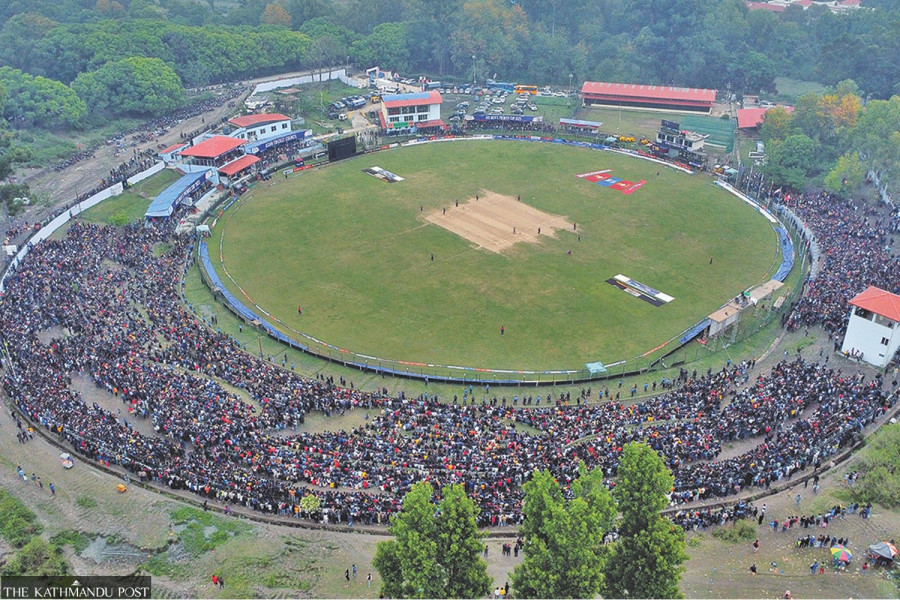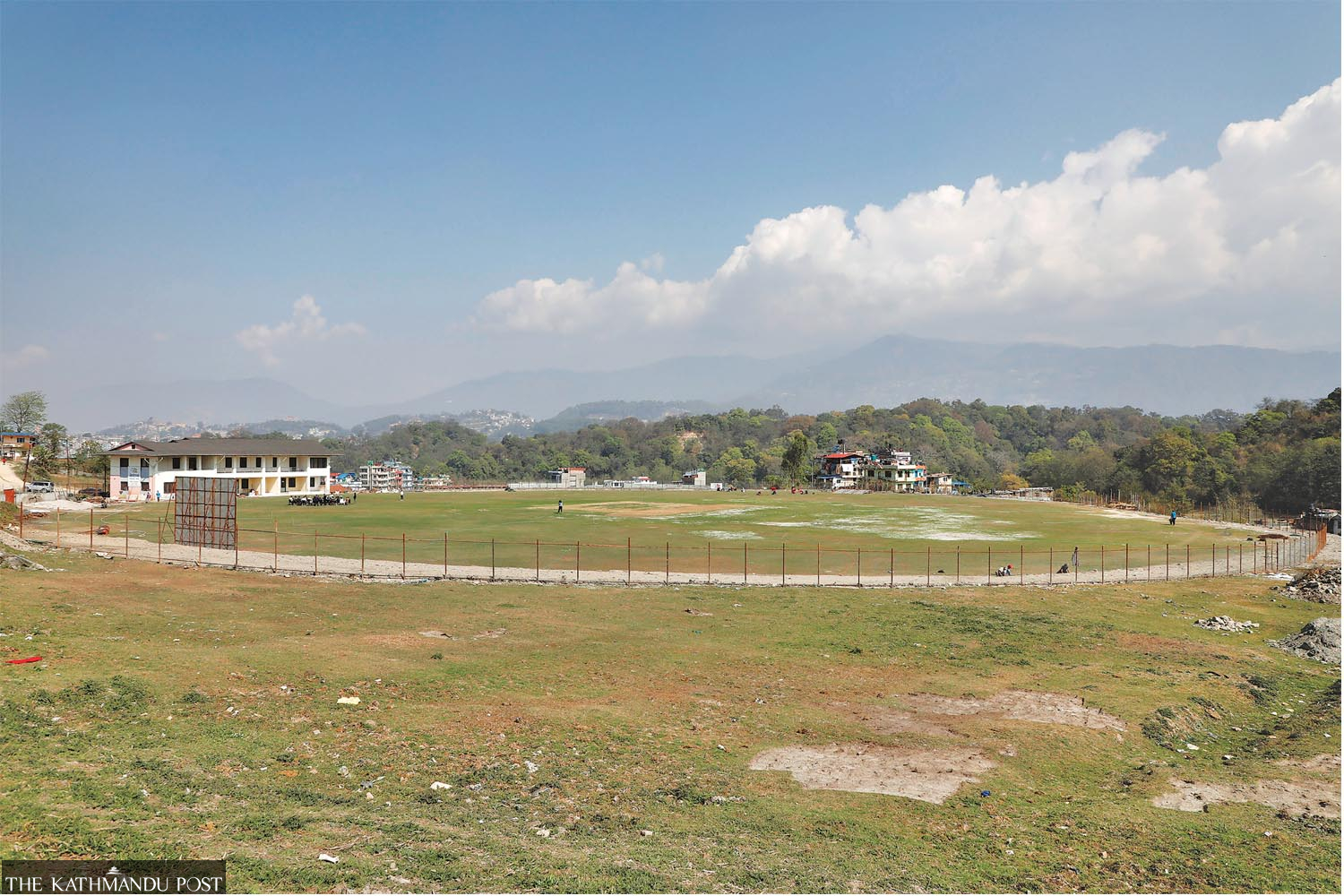Cricket
Nepali cricket sees fast-paced success. Why can’t stadium-building catch up?
Infrastructure development lags even as successive governments make big promises.
Prajwal Oli
Nepalis living in and out of the country euphorically celebrated their team’s victory over the United Arab Emirates (UAE) on Monday, May 2. The victory in the ACC Premier Cup final ensured Nepal will play against cricketing heavyweights India and Pakistan in the ACC Asia Cup.
The final match of the One Day International (ODI) was extended over two days due to the downpour on Sunday. The game witnessed a rare scene—thousands of spectators huddled under open umbrellas, which made the front page of most broadsheet dailies.
It was pleasing to see a huge crowd wait for the match to resume. But the game was called off midway for the day due to unplayable pitch conditions.
The devotion of Nepali fans was heartening, but the hard reality was that they had nowhere to take shelter in the stadium. Nepal does not have a single stadium of good standards, although cricket has gained unprecedented popularity in the country over the past two decades.
The game was introduced in Nepal in the 1920s, according to the governing body Cricket Association of Nepal (CAN), which was registered with the National Sports Council (NSC) in 1961. The men’s team first competed in an official international game in 1996 during the ACC Trophy in Malaysia while the women’s team marked their international debut in 2007.
Since then the men’s team have made waves in the shortest format of the game, appearing in the 2014 World T20 in Bangladesh. The team got elite cricket team status in the ODIs in 2018 for four years, which was extended by a year due to the Covid-19 pandemic.
The team recently retained their ODI status after taking the cricketing world by storm, securing 11 victories in their last 12 games of the ICC World Cup League 2. Nepal exceeded their own expectations by retaining the ODI status.
Only two Nepali grounds—the TU ground and the Mulpani ground—hosted the recently played ACC Premier Cup.
While the TU ground was the venue for its first international event in ACC Trophy in 1998, it was the first occasion that Mulpani had held an international event. Prior to the ACC Trophy, the Asian Cricket Council (ACC) had set a mandatory requirement of four grounds to host the event. The CAN had constructed two grounds at Pulchowk Engineering College and one at St Xaviers, apart from the TU ground.
Twenty-five years after hosting the ACC Trophy, the CAN hosted a similar tournament at TU, but almost all facilities and the infrastructure there remain the same.
Tribhuvan University ground
The TU cricket ground, originally meant for football, took the current shape after Indian Zee TV came to Nepal looking for space to develop a neutral venue for India-Pakistan games, recalls former CAN president Binay Raj Pandey.
“The India-Pakistan games would normally take place in Sharjah of the UAE and they came looking for land in Nepal in 1992. Initially, in 1994, the CAN acquired the land on lease for five years from Tribhuvan University. Construction was started the same year and the ground was ready to host the 1998 ACC Trophy. Zee TV gave the ground its current shape and design in coordination with us,” said Pandey, the general secretary of CAN from 1995 to 2002.
“I think they later changed their mind after the Maoist insurgency broke out in Nepal. They might have thought it was unsafe,” said Pandey, who also served as CAN president from 2005 to 2010.
“Before TU ground, Tundikhel was the only proper place to play cricket. We developed two grounds, one at the Pulchowk Engineering College, and the other at St Xavier’s for the 1998 ACC Trophy within a span of two years,” said Pandey.
Following the team’s victory over the UAE last week, a Cabinet meeting decided to allocate the budget to upgrade the TU ground to international level. But a roadmap for the project is yet to be finalised.
“I discussed the matter with Prime Minister Pushpa Kamal Dahal after Nepal’s win over the UAE in the final. A Cabinet meeting has decided to allocate the required funds for upgrading the facilities at the TU grounds, which means it will get priority at the policy level and at the National Planning Commission,” said Tanka Lal Ghising, member secretary of the National Sports Council. “We have already started a study on the upgrade. It will be announced in the budget for the next fiscal year."
Mulpani ground
The construction of Mulpani Stadium began as early as 2006, but remains incomplete in what is one of Nepal’s longest incomplete infrastructure projects. Should construction be completed as per the masterplan, the stadium will have a 30,000 seating capacity along with other facilities, including changing rooms, a media zone, an academy, a gym and a swimming pool.
Once a dumping site, the land owned by the NSC is spread ovre 296 ropanis of land.
According to RK Bista, a local and also the coordinator between National Sports Council (NSC), Ministry of Youth and Sports, CAN, the local government and Kageshwari Manohara Municipality for stadium construction, at current pace, the construction will take a decade to complete.
“As per the master plan of the stadium, only 40 percent of construction work is complete,” said Bista, appointed coordinator in 2013.
Planning for the Mulpani ground started in 2002 after the International Cricket Council (ICC) wanted to build a Global Cricket Academy in Nepal. But the Mulpani project was later shifted to the UAE owing to security reasons.
In 2006, the CAN initiated construction with the support of Asian Cricket Council (ACC) and the government of Nepal, according to former CAN president Pandey.
“The ACC had initially supported us with Rs10 million and the government had also invested around Rs40-Rs50 million between 2006 and 2010. The current CAN headquarters and the work of levelling the ground were completed in 2010,” said Pandey.
Since 2011, the Nepal government has injected millions of rupees but construction has progressed at snail’s pace.
According to the NSC, the executive sports body of the country, construction has now reached the second phase. While the first phase got a budget of Rs178.5 million, Rs288.4 million was set aside for the second phase. The NSC blames small instalments of budget allocation for delays.

According to Pasang Sherpa, the chief of the financial department at NSC, a budget of Rs22 million was allocated in the last fiscal and Rs70 million in the current fiscal year. “This outlay is way too slow,” said member-secretary Ghising.
While Rs40 million was allocated in the fiscal year 2070-71 BS, the outlay reached Rs50 million in each of the next two fiscal years. Likewise, Rs20 million was given in 2074-75, Rs10 million in 2075-76, Rs100 million in 2076-77 and Rs10 million in 2078-79 BS.
“We have written to the Ministry of Youth and Sports and the Ministry of Finance to ensure a budget of Rs1.25 billion, so that we could speed up construction,” added Ghising. “With sufficient allocation, the whole Mulpani project could be completed in 24-30 months.”
Among the two grounds in Mulpani, Nepal hosted some matches of the recently-held Premier Cup at the upper ground, which also houses CAN offices.
According to CAN acting secretary Durga Raj Pathak, the ACC and the Kageshwori-Manohara Municipality supported them in upgrading the facilities for the Premier Cup. But the CAN is currently working on the lower Mulpani ground.
Dhurmus-Suntali Stadium
The Gautam-Buddha International Stadium, initiated by actors Sitaram Kattel and his wife Kunjana Ghimire in March 2018, should have been completed by 2021.
The proposed site that sprawls over 20 bigha and six kattha land at the Forestry University premises in Bharatpur was to be handed over to Bharatpur Metropolitan City upon its completion. The estimated budget was Rs3 billion.
But the actor duo’s Dhurmus-Suntali Foundation withdrew from the project in July 2021 citing a financial crunch. They also publicly appealed to the Bharatpur Metropolitan City to take ownership—the metropolis has not.
As per the government's valuation, only 14 percent of construction had been completed while Kattel claims 32 percent of the work has been done. The Office of the Auditor General says Rs620 million has been spent on the project; a private audit report shows Rs580 million in expenditures.
The stadium project is currently in limbo with only security guards appointed by the foundation looking after the site.
Why the delay
Sports and sports infrastructure have never been a priority of Nepali policymakers and governments, says senior sports journalist Ajay Phuyal.
“Every finance minister in the past decade and half has vowed to give the Mulpani stadium top priority in their budget speech,” he added. “The political leadership competes to congratulate players when Nepal wins international fixtures. They heap praises and even announce lucrative cash prizes. But shouldn’t they first ensure that Nepali players have good grounds to play on?”
Phuyal also points out flaws in the CAN's leadership. “The CAN, as an authorised body, should have been able to make policymakers and leaders understand the game’s value and lobbied accordingly. If the state mechanism and leadership are serious, building a couple of stadiums is not a big deal,” he says.




 17.13°C Kathmandu
17.13°C Kathmandu















